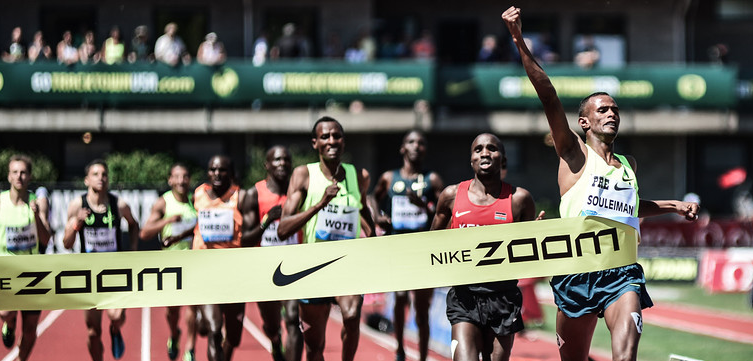The Monday Morning Run:De Grasse's contract is way bigger than you thought
Kevin Sully | On 07, Dec 2015
Something extremely rare happened on Friday in the track and field universe. Canadian sprinter Andre De Grasse signed a professional contract with Puma, foregoing his senior year at USC.
That wasn’t the strange part though. Collegiate runners leave NCCA running early frequently. This year alone, American sprinters Trayvon Bromell and Jenna Prandini announced they were skipping their final season of eligibility after they had successful seasons that ended at the World Championships.
What was different about the De Grasse signing was that it came with numbers. $11.25 million with up to $30 million in bonuses. Not every detail was disclosed, it was called a “multi-year” deal and there wasn’t a specification on how the bonuses were structured, but this is infinitely more contract information than is usually released in track and field. The assumption, according to the reporter who broke the story, is that the deal is for five years, locking him up for the next two Olympics. That would put his base pay at $2.25 million per year.
This information shouldn’t be a huge deal. The athlete, sponsor and agent all have an interest in the public hearing about the size of deal. With track and field, it still feels like a Wikileaks disclosure, as if the information was somehow discovered through backchannels and not freely offered to a journalist.
Track has a complicated relationship with these topics. Prize money, of course, is public information. Appearance fees sometimes trickle out, especially if it relates to Usain Bolt. But base pay from primary shoe sponsors is usually mum from athlete and sponsor. You can embark on a Google scavenger hunt if you’d like to try and find some hard numbers, though that yields mostly speculation. There’s a mention about Allyson Felix’s Adidas contract in this article from 2004, but nothing but guesses on her Nike deal that she signed in 2010. That’s typically the norm. In the De Grasse article, there is a mention of Bolt’s Puma deal–$10 million per year. Bolt is such an outlier though that it doesn’t give us much an indication on the worth of other athletes.
One exception was Alan Webb. When he signed with Nike there was solid reporting that said the amounts was for six years and $250,000 per year. It’s hard to use this as a benchmark because early 2000s Webb didn’t represent the norm. He just broke a famous record, was young, ran in a glamour event and had crossover appeal (see his Letterman appearance). At the time, $250,000 was considered a huge deal. Other milers joked about how Webb should be buying them drinks. So if $250,000 in 2002 was a monumental deal for a young talent, what is $2.25 million in 2015? They aren’t exact parallels (Canadian sprinter, American miler) but we’re working off the Webb deal just because it’s one of only known quantities in contracts.
Like Webb, De Grasse’s biggest asset is potential. But De Grasse also has an entire country to himself and he already has a championship medal. He’s the biggest track athlete in Canada, a country that pays attention to track and field, at least more so than in the United States. Still, it’s a huge jump from those two numbers, even after you adjust for inflation. That’s why the only thing more surprising than the numbers being released was how big the numbers actually are.
This of course leads to questions about other deals. How much does a distance runner with a similar profile to De Grasse fetch? What did Puma pay Jenna Prandini, the other NCAA championship sprinter that they signed? And what about De Grasse’s equal at World Championships, Trayvon Bromell? All of these questions exist because there is so little information on the topic. I’m not one who cares much about the length and structure of contracts in other sports. All the millions start to run together and discussing salary cap and sponsorship deals isn’t really why I became interested in sports in the first place. Track has enough numbers involved in it without having to include dollars.
But since we’ve all been starved for any information on what a professional track and field athlete makes, it’s hard not to be curious. If you are sports fan in the United States, not only do you know how much the Rockets pay James Harden (5 years/$78 million), but you also know how much Adidas gave him to wear their shoes ($200 million for 13 years). Track, and other “Olympic sports” as well, seem set on keeping most financial information in the dark even if the numbers project a positive image. One theory I’ve heard is competing sponsors don’t want the financial information out because it allows them to keep contracts low. I’m not sure why that would just apply to sports like track and field. Maybe people in other sports just look harder for the details and the involved parties are more likely to offer it up since it involves large sums of money.
De Grasse’s deal surpassed my expectations of what the market is for an ascendent sprinter in 2015. Assuming his contract is for five years, his base salary is higher than all but the top eight picks in this year’s NBA Draft. The 31st pick in April’s NFL Draft signed for around $2.9 million per year if you include contract and signing bonus. The seventh pick in the NHL Draft is scheduled to make $2.77 million this year. Of course there are bonuses and different clauses that make all these numbers flexible, but before Friday I wouldn’t have believed a NCAA champion sprinter could get paid anywhere near what a lottery pick in the NBA earns.
Points for track and field.
It also important to remember how rare De Grasse is. Not just his times and accomplishments, but the situation he is stepping into. He signed with a company whose largest commodity is ending his career in the next two to three years. Bolt’s eventual absence creates more space, and presumably more cash, for De Grasse. In terms of timing, one year out from the Olympics is the ideal time to have your breakout season. So besides from being better than virtually everyone who has ever come out of the NCAA system, and competing in the most popular event, De Grasse has some advantages that undoubtedly made him more appealing for Puma. While it’s cool to think that NCAA track stars pull in more money on a first contract than whoever the Chicago Bulls drafted in June, don’t forget that De Grasse is a rarity. The NBA/NFL/NHL pay this kind of money out every year, not just to transcendent talents.
And what impact, if any, will the De Grasse deal have on the sport? Will it force Nike and Adidas to offer more in the future? Will it lead to more transparency on contracts? Will there be a run on sprinters causing the fourth fastest guy from the Pac-12 to sign for an ungodly amount of money? Probably not the last one.
As for the man himself, the money will have a negligible impact on his performance. Whether he signed for two million dollars a year or $200,000, his success or failures won’t be because of a contract. His decision to turn professional was pretty straightforward. He’s staying in Los Angeles, keeping his coach and will still attend classes at the university. There is no reason to think he won’t continue to improve now that he has more another year of experience and more freedom to choose his races. The changes will be few–he will be wearing a different uniform, compete less frequently and, like Webb, probably get stuck with the check wherever he runs throughout the world.



















Comments